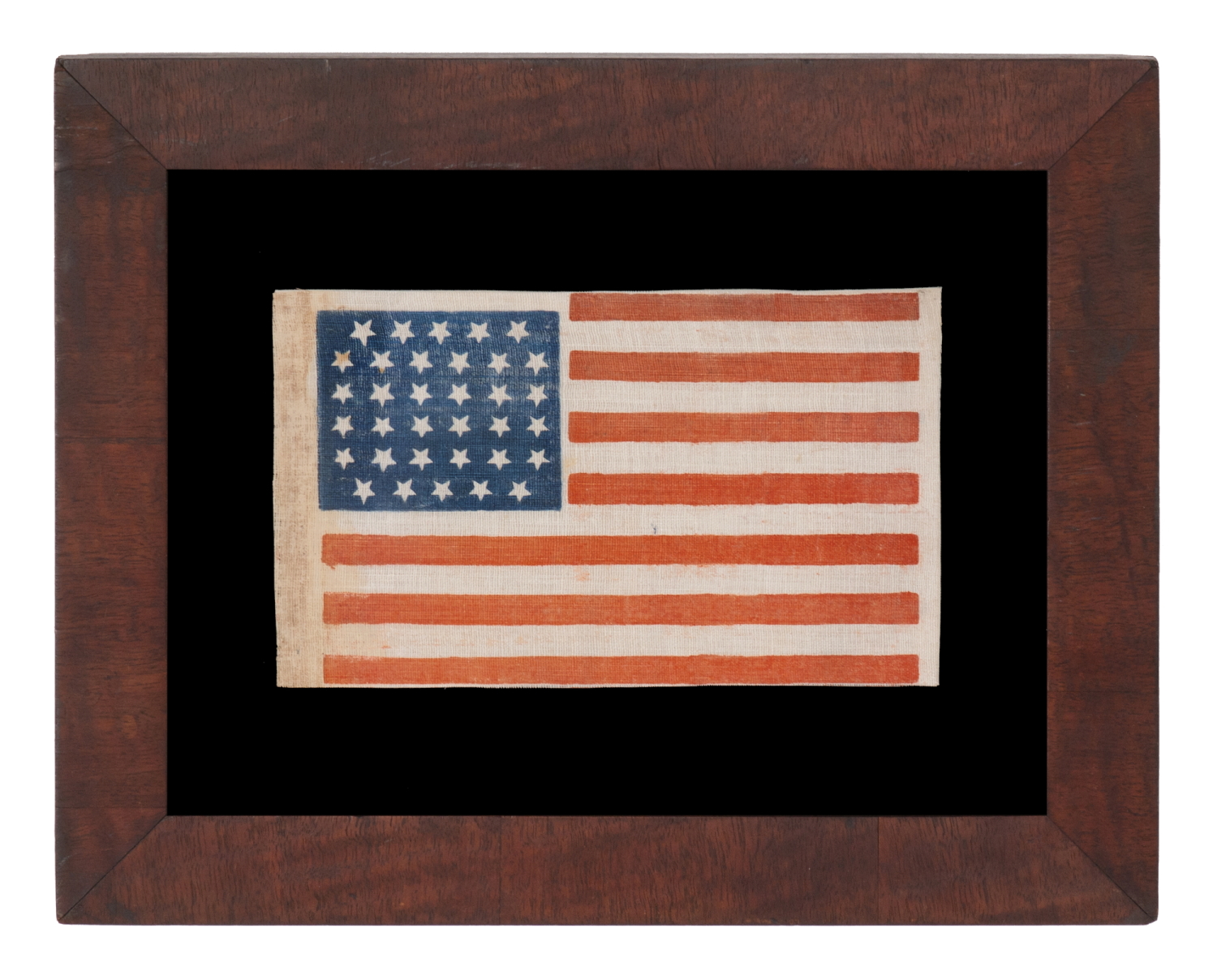
| |
34 STARS IN A LINEAL ARRANGEMENT THAT RESULTS IN A CONFIGURATION THAT I HAVE TERMED "GLOBAL ROWS," ON AN ANTIQUE AMERICAN FLAG MADE DURING THE OPENING TWO YEARS OF THE CIVIL WAR, 1861-63, KANSAS STATEHOOD |
|
| Available: |
Sold |
| Frame Size (H x L): |
11.5" x 14.5" |
| Flag Size (H x L): |
5.25" x 8.5" |
|
| Description....: |
|
34 star American national flag, printed on cotton. Kansas was admitted into the Union as the 34th state on January 29th, 1861, about 2 ½ months before the Confederate assault on Fort Sumter that marked the beginning of the Civil War. The 34th star was officially added on July 4th of that year, but most flag makers would have added a 34th star with the addition of Kansas in January. The star count remained official until July 4th, 1863, and 34 star flags would have generally been produced until the addition of West Virginia in June of that year.
34 star parade flags are scarce. Prior to the Civil War, Americans did not employ the flag in many of the ways we do today. Before that time private citizens generally did not fly flags off their porches or wave hand-held examples like this one at parades and rallies. Flags were primarily a tool of the military--particularly the U.S. Navy. It wasn't until Confederate forces fired upon Fort Sumter that a surge of patriotism caused a great increase in the making and consumption of the Stars & Stripes by the general public. It was then that flag-makers began to produce them in quantity for the first time. This flag would have been among some of the first made for that purpose.
The stars are arranged in justified lineal rows of 5-6-6-6-6-5. This results in secondary configuration that I refer to as “global rows”, because the star pattern resembles a global map, with a narrow, vertical oval of stars in the center and parentheses to either side, the overall look of which resembles longitudinal lines.
Note how all of the stars are positioned with two points up instead of one and thus are effectively upside-down with respect to modern convention. Unlike the current flag, versions of the Stars & Stripes made prior to 1890 often displayed stars that were varied or completely random in their orientation a vertical axis. Note how the feature draws attention and is unusual to the eye.
Also note the beautiful, burnt orange hue of the red stripes and the fact that they do not line up appropriately with the canton. This adds a crude and interesting feature.
All-in-all, a wonderful example of the Civil War period with strong colors and a number of interesting characteristics.
Mounting: The flag was mounted and framed within our own conservation department, which is led by expert staff. We take great care in the mounting and preservation of flags and have framed thousands of examples.
The rosewood veneered molding dates to the period between 1830 and the 1850's. The background is 100% cotton twill, black in color, that has been washed and treated for color fastness. Spacers keep the textile away from the glazing, which is U.V. protective glass.
Condition: There is modest to moderate soiling in the white area along the hoist end, venturing into the white fabric in the body of the flag. Professional cleaning was undertaken in this region, along with minor color restoration. The latter was done in such a way as to be minimally invasive and retain as much of the original patina as possible. There is extremely minor staining in the body of the flag and one extremely tiny spot of blue where it doesn’t belong. The printing in the canton is a little light in the top 2/3 toward the fly end. Many of my clients prefer early flags to show their age and history of use. |
|
|
|
| Collector Level: |
Intermediate-Level Collectors and Special Gifts |
|
| Flag Type: |
Parade flag |
|
| Star Count: |
34 |
|
| Earliest Date of Origin: |
1861 |
|
| Latest Date of Origin: |
1863 |
|
| State/Affiliation: |
Kansas |
|
| War Association: |
1861-1865 Civil War |
|
| Price: |
SOLD |
|
| |
Views: 110 |
|
|
|

